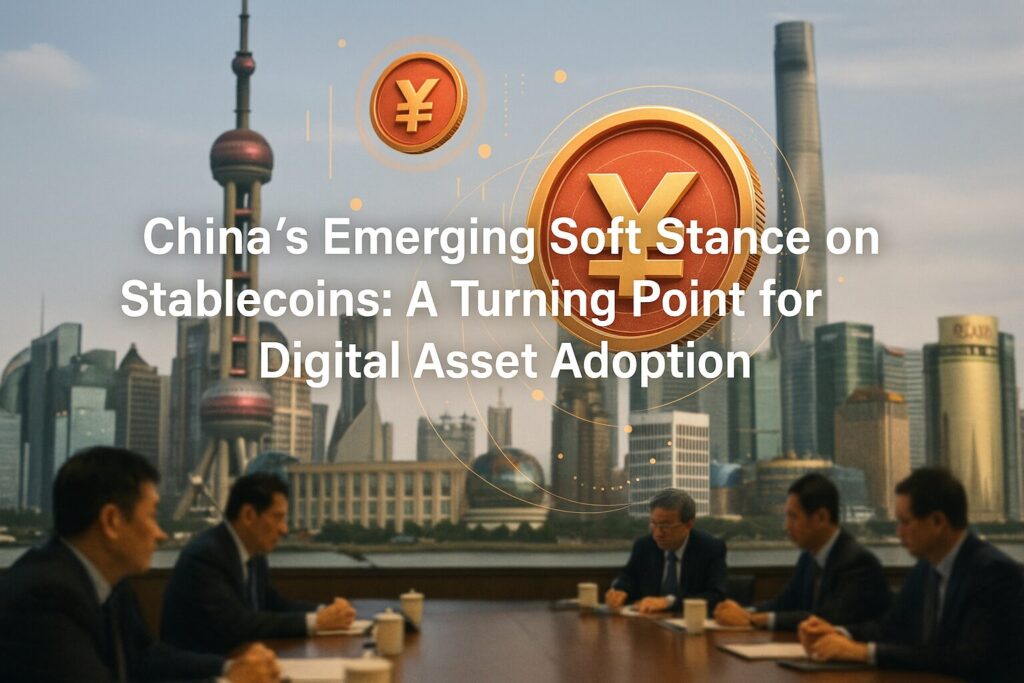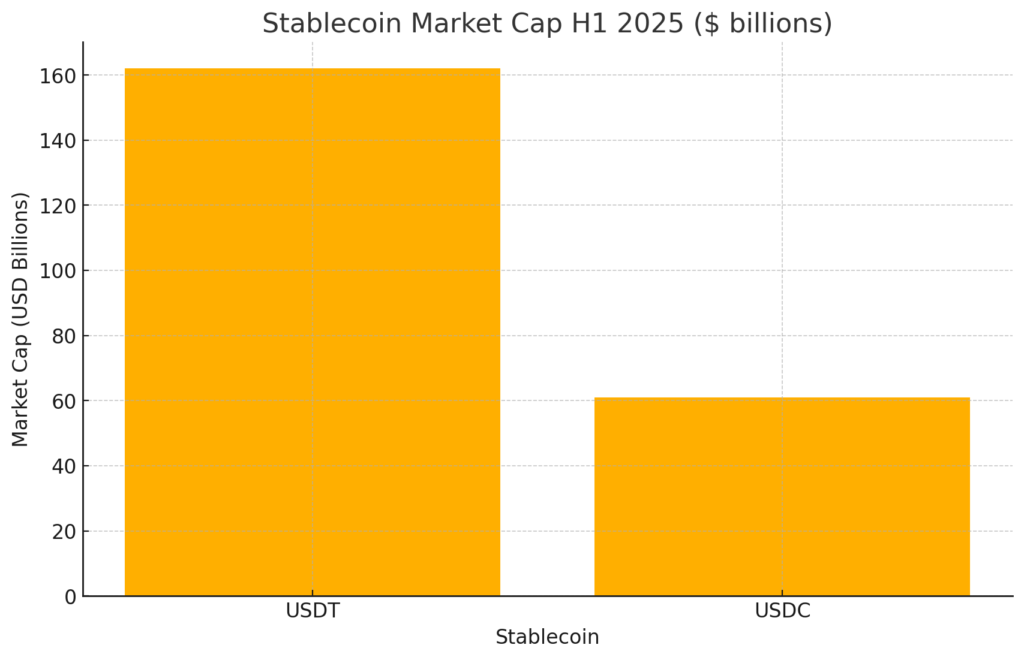
Main Points:
- China’s historic crypto crackdown contrasts with recent Shanghai policy meeting signaling openness to stablecoins.
- PBOC Governor Pan Gongsheng and senior advisors emphasize research and potential of yuan-pegged stablecoins.
- Domestic tech giants and experts lobby for offshore issuance in Hong Kong, leveraging its freer capital regime.
- FTX China repayment saga intensifies speculation of broader regulatory easing, though core ban remains.
- Global market context: stablecoin market cap reached $252 billion in H1 2025 with USDT and USDC dominating; cross-border usage volumes soared.
- Key risks include regulatory fragmentation, illicit finance concerns, and financial stability implications.
- Implications for investors: potential new yield-bearing yuan-stablecoin products, opportunities in on-chain cross-border payments, and evolving DeFi integrations.
Background: China’s Crypto Crackdown and Stablecoin Ban
Since 2021, mainland China has imposed one of the world’s strictest bans on cryptocurrency trading and mining, culminating in a blanket prohibition on domestic exchanges and custodial services. Despite this, the People’s Bank of China (PBOC) accelerated its digital yuan (e-CNY) pilot programs, emphasizing state-controlled digital currency over decentralized tokens. This hardline stance has persisted amid global stablecoin growth, where dollar-pegged tokens exceeded $250 billion in market cap by mid-2025.
Shanghai’s Strategic Meeting Signals Policy Shift
On July 10, Shanghai’s State-owned Assets Supervision and Administration Commission (SASAC) convened a high-level meeting to “strategically respond” to stablecoins and digital currencies, attended by over 60 officials. The next day, SASAC Director He Qing posted on the authority’s official account urging “greater sensitivity to emerging technologies and enhanced research into digital currencies.” This rare public nod from a central locality regulator marks a potential turning point in China’s traditionally rigid stance.
PBOC’s Recognition of Stablecoins’ Global Impact
The PBOC, vigilant of the US dollar’s dominance via Circle’s USDC and Tether’s USDT, has taken notice of global stablecoin adoption, which facilitated over $4.6 trillion in transactions in H1 2025 across 1 billion on-chain movements. In June, PBOC Governor Pan Gongsheng acknowledged that “emerging technologies” like stablecoins could transform international payment systems, fueling calls within China for regulatory frameworks to support yuan-pegged variants.
Industry and Expert Calls for Yuan-Pegged Stablecoins
Leading Chinese tech firms—including JD.com and Ant Group—have publicly lobbied the PBOC to authorize offshore yuan-pegged stablecoins, citing the need to counter US dollar hegemony in digital finance. Domestic experts argue that a yuan-based stablecoin could strengthen the renminbi’s global role, enhance cross-border remittances, and open new on-chain investment opportunities for institutional and retail investors alike.
Hong Kong as a Sandbox for Offshore Yuan Stablecoins
Given mainland capital controls, many see Hong Kong’s forthcoming stablecoin legislation (effective August 1, 2025) as an ideal sandbox. PBOC advisor Huang Yiping highlighted that, with a robust offshore renminbi market in HK, issuing a yuan-pegged token there could lay groundwork for future mainland pilot zones. This approach mirrors the dual-track strategy: test innovation offshore before considering cautious domestic adoption.
FTX China Repayment Saga Fuels Speculation
Speculation over China loosening crypto rules intensified after FTX’s bankruptcy trustee sought to freeze repayments to “restricted jurisdictions,” including mainland China, where 82 % of affected claims reside. Over 300 Chinese creditors filed formal objections on July 8, 2025, arguing that “China does not prohibit holding crypto assets.” The US bankruptcy court’s ruling (expected July 22, 2025) may offer further clarity on China’s unofficial stance toward crypto holdings.
Global Stablecoin Market Trends and China’s Position
Global stablecoin market cap surged to $252 billion in H1 2025, a 23.5 % increase year-over-year, with Tether (USDT) at $162 billion and USDC at $61 billion.
Figure 1: Stablecoin Market Cap H1 2025
Insert Figure 1 here after this paragraph.

This dominance underscores the US dollar’s primacy in digital finance; yet, emerging regulatory frameworks in Europe (ECB warnings) and the US (GENIUS Act) are driving diversification and broader adoption.
Risks and Regulatory Considerations
While the push for yuan-pegged stablecoins offers strategic benefits, key risks persist:
- Financial Stability: Rapid issuance without robust reserves or oversight could destabilize local markets.
- Regulatory Fragmentation: Divergent rules between mainland China, Hong Kong, and global jurisdictions complicate compliance for issuers and users.
- Illicit Finance: Anonymity features pose AML/CFT (anti-money laundering/combating financing of terrorism) challenges, echoing ECB concerns over dollar-pegged tokens.
Implications for Blockchain Adoption and New Crypto Opportunities
For investors and blockchain practitioners, China’s nuanced shift presents fresh avenues:
- Yield-Bearing Products: Anticipate on-chain stablecoin lending/borrowing markets denominated in yuan.
- Cross-Border Payments: Firms can pilot renminbi-denominated rails in trade corridors, reducing FX friction.
- DeFi Integration: A regulated yuan stablecoin may unlock collateral diversification in DeFi protocols, enhancing liquidity options.
Conclusion
China’s tentative softening of its stance on stablecoins—heralded by Shanghai’s SASAC meeting and PBOC acknowledgments—signals a pivotal recalibration. While mainland bans on trading persist, the prospect of offshore yuan-pegged tokens, tested in Hong Kong, offers a pragmatic path for innovation. Against the backdrop of a $252 billion global stablecoin market and $4.6 trillion in H1 2025 transactions, this strategic pivot could shape the next frontier of digital asset adoption. For crypto investors and blockchain builders, understanding China’s evolving regulatory landscape will be key to capturing new opportunities in yuan-denominated finance.

